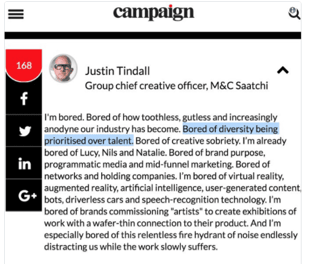When sex stopped selling
By Burn •
- Advertising
Last Monday, Advertising Week met for a candid panel called ‘The Truth About Gender Bias in Ads in 2017,’ to ignite conversations around the proverbial hamster wheel of gender stereotyping.
Madeline Di Nonno, chief executive officer of the Geena Davis Institute on Gender in Media, opened the panel with some astonishing statistics which left her fellow panelists shaking their heads with sheer incredulity. The stats originate from a study conducted by the Institute after nearly a decade of research around gender representation in advertising. The results revealed that men were onscreen four times as often as women with seven times more speaking roles. Men were nearly three times more likely to be characterised as “humorous” and were often immersed in driving, sports, and other outdoor activities. In a massive *twist,* women appeared most often in a domestic setting (Shock! Gasp! Eye roll.)
Di Nonno stated that research shows that “women are [also] getting younger and dumber.” This is reflected in the average age of women in television spots (the mid-20s) compared to men their late-30s, giving women one-third of the volume of dialogue of men (the language being predominantly monosyllabic words) and portraying women as “discernibly intelligent” only 61 percent of the time.
It may seem like I’m merely firing off statistics and complaining, but what this research shows is a thriving, insidious trend in spite of our strides in gender blurring. As Di Nonno concluded, “the study revealed a level of unconscious bias we didn’t think possible.”
Having said that, there is a new climate, with daily arguments in the media about gender bias, pay gaps, harassment, sexploitation, objectification, mansplaining and manspreading, alongside discussions of gender fluidity, gender-neutral language and LGBTQIA equality. We’re talking about gender more than ever – but it’s with hopeful optimism that these conversations, arguments, and guidelines will instigate positive changes.
Already, new guidelines set for 2018 from the Advertising Standards Authority will crack down on depictions of stereotypical gender roles. Brands should take the example of John Lewis and Target, with both brands currently seeking to combat gender stereotyping by releasing a line of gender-neutral clothing for children and de-gendering marketing comms and packaging across product lines.
At BURN, naturally we’re of the mind that the traditional binary notion of gender is simply not the way forward – this is not limited to advertising, but across multiple spheres such as branding, manufacturing or education. We’re far from alone in this opinion, ask almost anyone from agency or client-side and you will receive resounding agreement. The question that remains is why’s gender-stereotyping so prevalent? Maybe the answer lies in more draconian statistics, with women making up more than half of junior agency roles, but only 30% of positions of leadership, according to data from the Institute of Practitioners in Advertising. It’s time to exist along a spectrum and stop placing so many stakes in rigid stereotypes and binaries.


